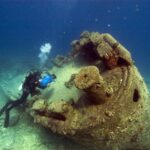Build a Sustainable and Beautiful Aquarium
When it comes to choosing saltwater fish for your reef tank, it’s important to remember that you’ll want to only choose those that won’t damage or consume the various corals, anemones, or other tank inhabitants that make up your tank.
When it comes to your reef tank aquarium, a delicate balance must be maintained to ensure the sustainability of the ecosystem. With each organism dependent on the other in some way, any disturbance (such as the introduction of unsuitable saltwater fish) can induce a cascade of issues.
In this article, we’ll go over the list of reef-safe fish that are generally considered safe for your reef tank.
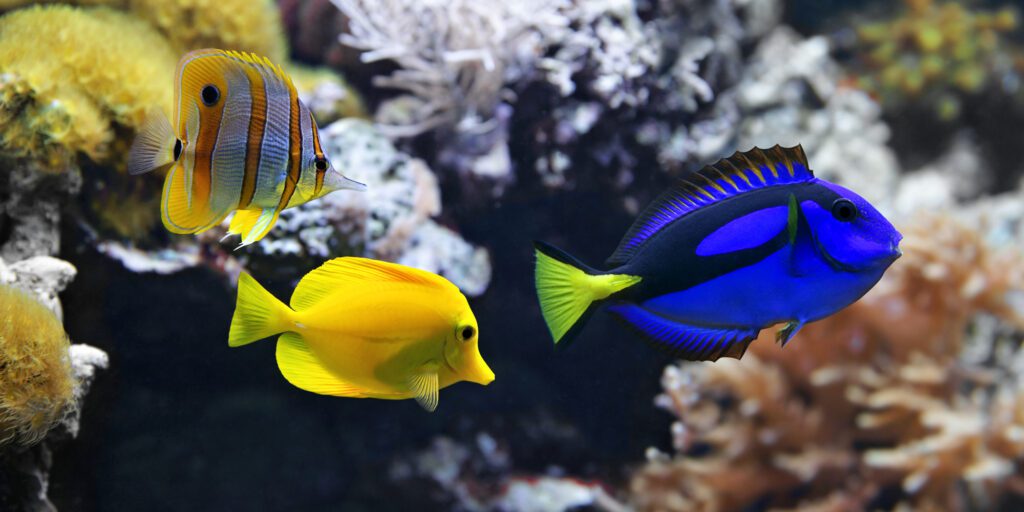
Understanding Reef Safe Fish
Before we get into the idea of picking out your reef-safe fish, let’s first go over the ideas of what these fish are and how they contribute to the overall reef tank ecosystem. From this, you’ll hopefully have a better idea of the importance of maintaining such animals.
What Makes a Fish “Reef Safe”?
Reef-safe fish is generally a distinction recognized by aquarium hobbyists as any fish or invertebrate that is safe to be introduced to a reef tank. “Safe” in this context means that the fish or invertebrate is unlikely to harm any of their tankmates that make up the reef tank.
Of course, it’s important to note that while these fish are called “reef safe”, there aren’t any fish that are truly safe for reef tanks; if you ever find a few standouts that don’t work out, it’s imperative to remove them from the tank before any major damage is done.
Ecological Impacts of Introducing Fish to Your Reef Tank
As mentioned earlier, it’s crucial to ensure that your reef tank’s ecosystem remains balanced. To better understand this, we should first understand the idea behind trophic/feeding levels.
Trophic (otherwise known as feeding) levels are a system where the primary producers (typically plants) are eaten by primary consumers (i.e. plankton) and they, in turn, are eaten by secondary consumers. At its peak, you reach an apex predator (tertiary consumer), where there are no further predators.
Since trophic levels make up ecosystems, any change in one level can impact the entire system in a chain reaction (i.e. too much demand can outstrip all food, or too much food can pollute the tank). In the case of new fish being added, this should mean that the trophic level below them (i.e. their prey) will see a decrease in abundance as they’re eaten. Because of this, the trophic level below that of their prey will increase in abundance due to the lack of predators. This trend then continues throughout all subsequent trophic levels until reaching the primary producers.
For example, if you introduce 2 new clownfish to your tank, you’ll likely need to increase the nutrients and light levels in your tank (to promote algae growth) since algae make up a big part of their diet. Although they also consume small crustaceans (which also consume algae, hence their loss should increase algae abundance), the effect probably won’t be enough to save the algae population from the clownfish. If they only consumed crustaceans, then you should expect the algae population to grow.
Top Reef Safe Fish for Your Aquarium
Here’s a detailed list of some of the most popular and beginner-friendly reef-safe fish you can consider adding to your reef tank.
1) Clownfish
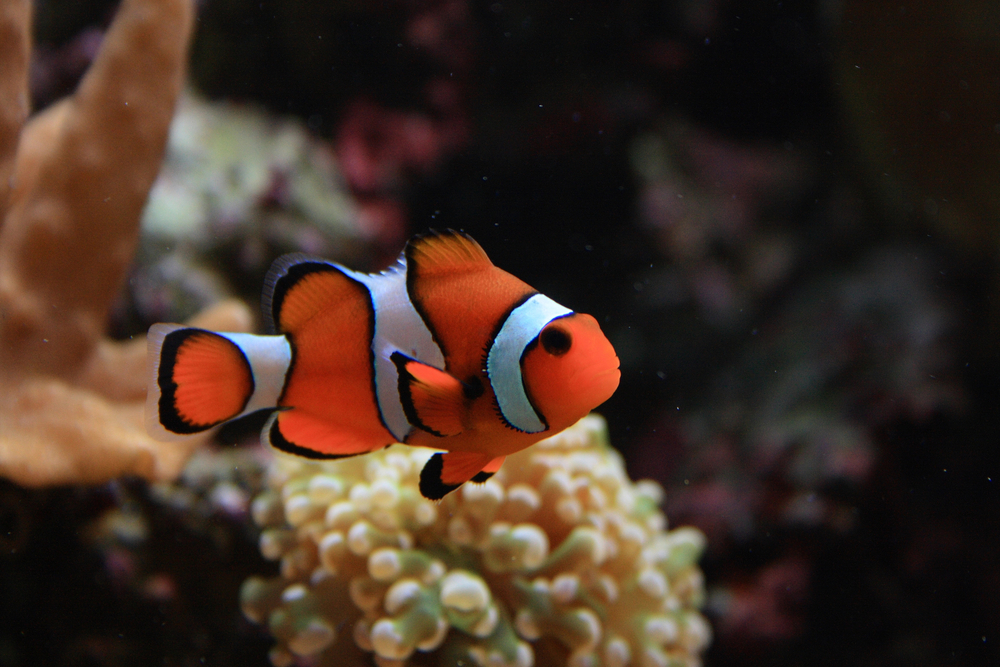
Clownfish
Color: Typically, bright orange throughout with three contrasting white bars. Some species can appear black throughout
Personality/Temperament: Bold, Territorial, Curious, and sometimes aggressive. It can be seen alone, in pairs, or as part of a school.
Compatibility: Clownfish prefer smaller and non-aggressive tankmates over larger and aggressive ones. Avoid mixing different species of clownfish
Sustainability: Clownfish live an average of 8 and 12 years in the wild and captivity respectively. Hundreds to thousands of eggs may be laid at once.
Care: Clownfish require a roughly 10 to 30-gallon saltwater tank with a biological filter. The water must be well-oxygenated. Routine feeding, light schedules, and the presence of live rock are needed to make the fish feel more at home.
2) Tangs (Surgeonfish)
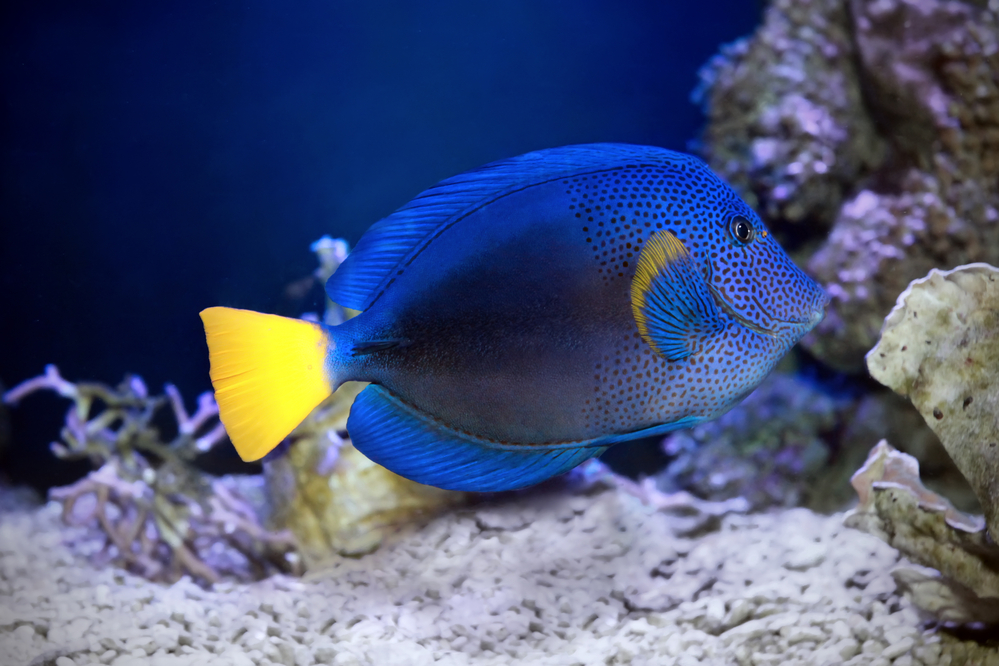
Tangs (Surgeonfish)
Color: Tangs vary in color greatly, and depending on the species, can include black, blue, brown, green, orange, purple, red, tan, white, or yellow. A combination of colors and patterns exist
Personality/Temperament: Tangs are generally peaceful, but may become aggressive with other tangs, especially those of the same kind. As some tangs are more aggressive than others, it’s best to place them in an aquarium in order of temperament, with the least aggressive first and most aggressive last
Compatibility: Being herbivores, tangs only eat algae and will leave the rest of the invertebrates, fish, and corals in your tank alone. They tend to be aggressive towards others of the same species, especially if some are added later to the tank
Sustainability: Most tangs live an average of 25 years (up to 30 if properly cared for). They can lay up to 40,000 eggs and hatch after a few days
Common Tang Varieties Include: Achilles, Pacific Blue, Blonde Naso, Red Sea Sailfin, Clown Surgeonfish, Purple, Chevron, Convict, Kole, Goldrim, Orangebar, Powder Blue, Sailfin, and Yellow
3) Blennies
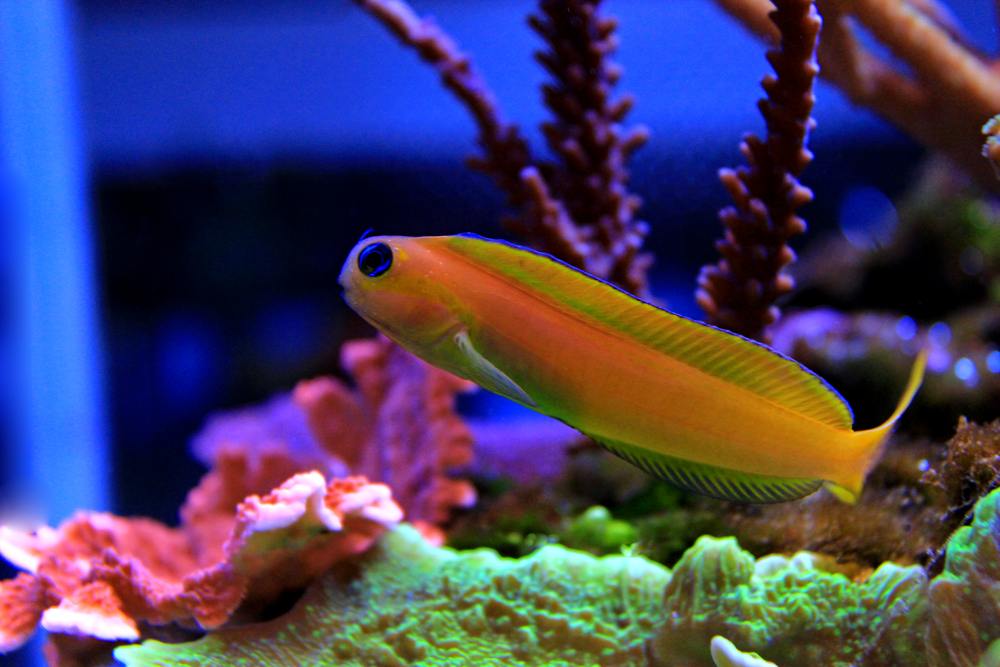
Blennies
Color: Blennies are known to color change; they can shift between gold, yellow, orange, red-brown, and dark brown, depending on their mood
Personality/Temperament: Blennies are overall not aggressive, and typically are calm and hyper-alert of their surroundings. May become belligerent with similar looking or their same species
Compatibility: Blennies are considered very beneficial reef-safe saltwater fish due to their temperament and the fact that they mainly consume small algae, copepods, and amphipods. While they may occasionally consume small ornamental crustaceans, blennies are overall very helpful to the reef ecosystem as they make up roughly 60% of all fish eaten in these reefs, providing much-needed nourishment to predators further up the trophic levels
Sustainability: The reason why blennies are so abundant despite being constantly consumed is because of their ability to lay hundreds or thousands of eggs at once. The eggs hatch within roughly one week.
4) Wrasses
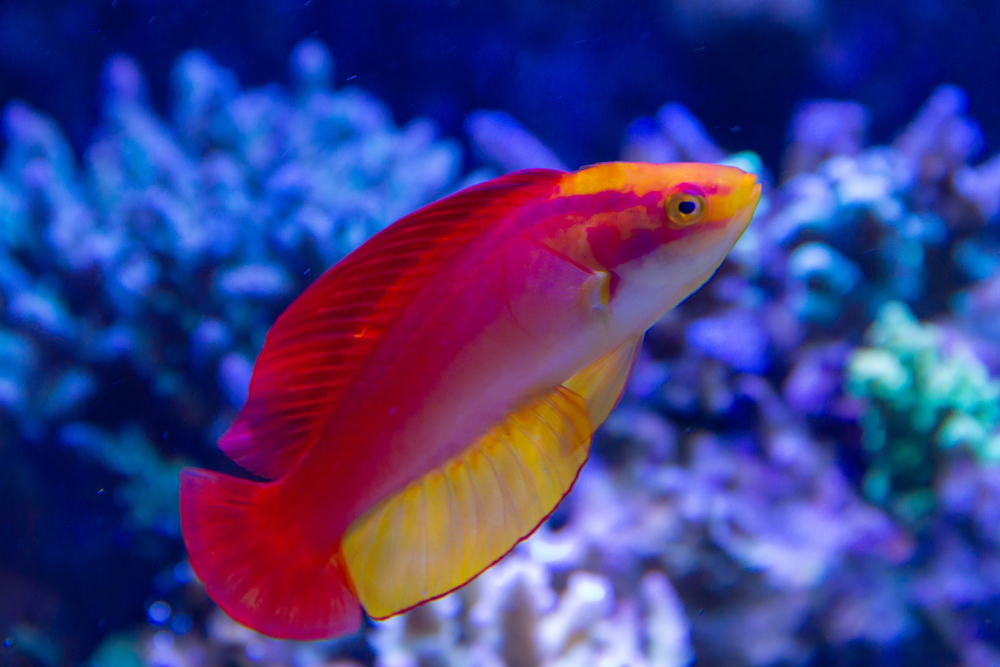
Wrasses
Color: Colors vary depending on species; primary colors include a dark cyan, green, or blue body accented by violets and purples
Personality/Temperament: The majority of wrasses won’t pick at or eat corals or other invertebrates (though some do; those are known as “not reef-safe” wrasses). As many are also active and curious by nature, they’re almost always found swimming out in the open
Compatibility: Different wrasse species are generally safe when kept together. Two males of the same species should be kept apart since they will often fight each other. In general, wrasses go along well with moderately aggressive fish, such as angels and surgeonfish.
Sustainability: Wrasses can lay tens of thousands of eggs, with the majority hatching within 24 hours of being laid
5) Sand Sifting Gobies
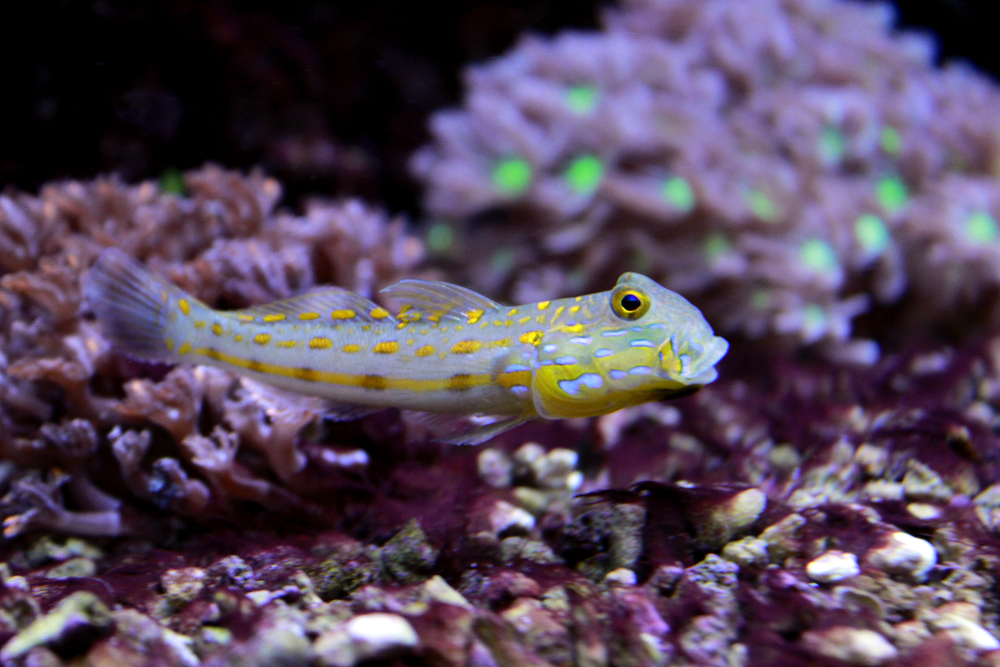
Sand Sifting Gobies
Color: Light gray overall, with light orange bands going across the fish. Its dorsal fin has a black spot on the bottom, with smaller white spots covering the rest of the fin
Personality/Temperament: Sand-shifting gobies sift through the substrate while consuming algae, detritus, and uneaten food, thus helping stir and aerate the sand. These gobies are quite peaceful and will reside in the sand-bed
Compatibility: Sand-sifting gobies are compatible with other non-aggressive fish. They may leap upward if startled, so it is best to separate them from aggressive fish
Sustainability: Roughly 30-40 eggs per spawn, hatching roughly 3-4 days later
Importance of Sustainable Sourcing
While the majority (90%) of ornamental fish is freshwater, there is an increasing demand for more brightly colored species that are native to tropical waters. This leads to a variety of issues that, if not properly managed, can lead to devastating effects on natural reef ecosystems.
Impacts of Unsustainable Fishkeeping Practices on Natural Reefs
Because coral reef ecosystems consist of a large diversity of fish, corals, and other invertebrates, unsustainable fishkeeping may impact several areas.
Recently, there have been those using toxic substances, such as sodium cyanide, to remove fish from the reefs. These easily kill coral polyps and algae, turning the once-thriving reefs into desolate wastelands.
High mortality (up to roughly 80%) is also seen in the removed fish, leading to a loss of key reef species. This can cause a ripple effect on both coral reefs and their dependent economies.
Additionally, some types of fishing gear can damage the coral reefs, seagrass beds, and other marine habitats.
Identifying Sustainably Sourced Fish
When it comes to choosing an ornamental fish, there are several ways of determining if the fish was sustainably sourced.
One is to determine if the dealer was compliant with the Ornamental Aquatic Trade Association’s code of conduct. If so, then they would have followed the specific guidelines for caring for and transporting the fish.
Another way is to see if the fish is from a protected species list (i.e. CITES), or if the list is in a country that neighbors the fish’s native country.[MOU2] For example, H. zebra (a species of catfish), though originating from Rio Negro, is often seen on lists of various other South American countries, indicating a possibility of illegal transportation with the intent to distribute. If either of these cases is true, then you should avoid purchasing said fish.
Overall, the idea is that you should avoid purchasing any fish if you’re unsure of their origins or how they were collected.
Sustainable Fish Suppliers/Certifications to Look For
Whether you’re looking to purchase sustainable fish for food or ornamental purposes, there are several places you can consider looking.
ORA (Oceans, Reefs, and Aquariums) is a great place to look for aquacultured saltwater fish, invertebrates, and live aquarium foods. As the largest ornamental hatchery in North America, ORA raises the fish themselves in an aquarium environment, making the fish very hardy while avoiding the issues of capture, handling, transport, or disease in wild-caught fish.
ORA also uses a specialized diet for each fish to ensure they are just as bright and colorful as those found in the wild.
When it comes to seafood, you can look for businesses with the MSC Chain of Custody Certificates. With the right Chain of Custody and license, the businesses may sell products with a blue fish tick on the product. This ensures that all seafood sold with the label originated from a certified sustainable fishery.
Tank Conditions and Maintenance for Reef Safe Fish
Tank Conditions for a Thriving Reef Aquarium
In regards to tank size, it’s recommended for beginners to choose one that is a decent size but isn’t too expensive. Beginners should strive for something between 50 to 175 gallons (90 is probably best).
With regards to water parameters, the following should be maintained to provide the best reef tank experience:
Calcium: 380-450 ppm
Alkalinity: 2.5-4 meq/L (7-11 dKH)
Salinity: 35 ppt
Temperature: 76 to 83 degrees Fahrenheit
pH: 7.8 to 8.5 is acceptable (8.1 to 8.3 preferred)
Magnesium: 1250 to 1350 ppm
Phosphate: < 0.03 ppm
Ammonia: < 0.1 ppm
Tips for Maintaining a Healthy Environment for Reef-Safe Fish
To provide the best environment for your reef-safe fish, it is essential to take a proactive approach to maintaining your tank. Here’s a couple of essentials to consider:
Regularly Monitoring the Water Quality
Test your water weekly for the pH, temperature, salinity, ammonia, and other parameters listed to ensure the water chemistry doesn’t harm the corals or fish, which can be quite sensitive.
Test kits may be purchased for use in marine aquariums, or you may take a sample of your water to your aquarium shop to be tested. Any abnormalities should be addressed promptly.
Use High-Quality Lighting
Purchase high-quality lighting (i.e. LEDs) that mimic natural sunlight, as corals depend on light for photosynthesis. LEDs are especially preferred due to their cost, energy efficiency, and customizable options.
Maintain Sufficient Water Flow
Water movement should be maintained to evenly distribute oxygen and nutrients to your tank inhabitants, and to prevent waste buildup.
Using a powerhead or wavemaker, or installing a sump pump or refugium are all ways to either create a current or increase water circulation.
Challenges and Solutions in Reef Tank Maintenance
Here are the most common issues you may encounter with your reef tank, and how to fix them:
Algae Overgrowth
High phosphate and nitrate levels can promote algae growth. Too much can lead to an overgrowth of algae that overwhelms your tank inhabitants.
Fixing the issue involves first removing as many algae as possible, then performing a water change every 3-5 days to lower the nitrate and phosphate levels. Maintain nitrate and phosphate levels to between 0.025 – 5 ppm, and <0.03 ppm respectively.
Cyanobacteria Overgrowth
Poor water movement and/or poor protein skimming, along with high phosphate and nitrate levels, can lead to a cyanobacteria bloom, which if left alone, can overwhelm and kill corals.
Check the RO-DI unit filters to ensure they’re changed regularly. Remove the cyanobacteria using a siphon or turkey baster, then change the water every 3-5 days.
Dinoflagellates Overgrowth
Dinoflagellates, typically long mucus-like strands, are caused by low nutrient levels (i.e. when nitrate and phosphate levels approach zero).
The first step is to remove as many dinoflagellates as possible with a siphon or turkey baster. Make sure to regularly change the filter socks before they become clogged.
Gradually increase the nutrient levels in the water so to prevent further growth of the dinos.
Feeding Your Reef Safe Fish
It’s important to feed your reef-safe fish food that is optimal and fit for the nutritional needs of each species.
Nutritional Needs of Common Reef Safe Fish
The nutritional needs depend on the type of fish you have. Herbivorous and carnivorous fish need a plant-based and meat-based protein diet respectively, while omnivorous fish should have a mixed diet of both protein types.
Regardless of the nutritional needs of each fish, it’s important to use naturally sourced ingredients whenever possible to appear similar to what the fish usually eat in the wild.
Recommended Foods and Feeding Schedules
For herbivorous fish, plants such as algae and seaweed are recommended, while carnivorous fish should receive their protein from foods such as shrimp, small fish, clams, krill, etc.
Dry food (i.e. flakes and pellets) contain roughly 50% protein and fat between 10-20%. Frozen foods have roughly 12% protein and 2% fat.
All foods should be small enough so that the fish won’t spit them out.
Pellets are recommended over flakes since they contain more nutrients per serving and are less messy.
Fresh and frozen foods should also be used as they can closely mimic natural food sources. However, you’ll need a strong filtration unit if you depend much on frozen foods due to them having excess water weight.
Foods containing fillers, such as corn, soy, or wheat should be avoided in all cases.
Multi-ingredient frozen foods and pellets should be enough to provide your fish with optimal nutrients.
When it comes to schedules, always feed your fish what they can consume in 1-2 minutes. Feed more times throughout the day if necessary.
Most reef-safe fish hobbyists feed their fish 1-3 times a day, but it ultimately depends on the nutritional demands of your particular fish.
How Feeding Affects the Reef Tank Ecosystem
The main issue has to do with overfeeding, where the leftover food and increased detritus can accumulate and release chemicals such as ammonia and nitrites, which are not only toxic to fish but can induce algal blooms.
Overfeeding can damage the fish’s health, and the poor water quality can weaken their immune systems.
Integrating Reef-Safe Fish Into Your Aquarium
Adding New Fish to Your Tank
- Turn the aquarium lights off
- Place the sealed bag with the fish on top of the aquarium water for 15-30 minutes, allowing the temperature of the sealed water to change to that of the aquarium
- Ensure temperatures are the same by using a thermometer
- Pour the fish onto a net over a sink to catch the water. Then release fish into the aquarium
- Feed some food to the original inhabitants to prevent them from picking on the new fish
- Leave the lights off for a few hours to allow the fish to settle without confrontation
Balancing the Ecosystem
Corals and invertebrates help filter the water when they consume the suspended nutrients from it.
While the small shrimps and crabs can scavenge the fallen detritus in hard-to-reach spaces, their intake is quite small. Thus, it’s still dependent on us to prevent overfeeding.
Successful Case Studies
If you look online, you can find a variety of success stories of people who built their reef aquarium from scratch and turned it into a paradise for reef-safe fish, filled with corals, invertebrates, and other inhabitants.
One such example is Danny’s Aquariums, which runs a YouTube channel focused on teaching beginners how to set up a variety of aquariums from scratch, including a shallow reef tank.
Another YouTuber who’s made a name for himself building terrariums and aquariums is Dr. Plants. In particular, he has a video of him constructing a reef ecosystem from scratch filled with clownfish, crabs, sea urchins, anemones, and others.
FAQs
1) What are the best fish to put in a reef tank?
Some of the best reef-safe fish include:
- Clownfish
- Surgeonfish
- Blennies
- Wrasses
- Gobies (i.e. Sand Sifting Gobies, Shrimp Gobies, Small Gobies)
- Angelfish
- Dragonettes and Mandarinfish
- Damselfish (i.e. Green Chromis)
2) What fish do not eat coral?
Japanese swallowtail angelfish and tangs/surgeonfish are known to never touch corals. While others described earlier are also considered reef-safe fish, these two types of fish are known to never interact with corals.
Conclusion
When choosing and caring for reef-safe fish, it’s important to know whether the fish are compatible with each other. Although they are mostly considered safe for reef tanks in general, it doesn’t mean none of them will ever act out or confront other fish.
Whichever fish you choose though, hopefully, you’ve come to realize the importance of sustainable fishkeeping, and that it’s truly on us to keep these elegant animals thriving in their natural habitats.


